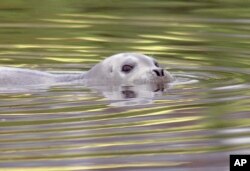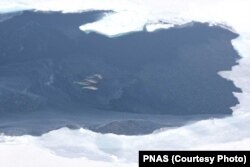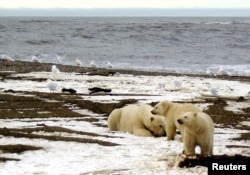The polar bear may be the classic poster child for climate change, but it is far from the only animal threatened by a warming Arctic. Because the region is warming two to three times more quickly than the rest of the planet, the rapidly melting sea ice is opening new shipping lanes. New research suggests increased vessel traffic through Arctic waters is putting narwhals and other cetaceans at risk.
The receding ice has cleared the historically dangerous Northwest Passage, and the Northern Sea Route along Russia's northern coast, dramatically increasing maritime traffic in what was once relatively untouched ocean.
"We're on the precipice," Donna Hauser from the University of Alaska Fairbanks said. "We're poised for a lot of vessel traffic to increase in the Arctic. Part of what motivated the study [was to] understand where we're at and where we need to go."
Hauser was interested in assessing the vulnerability of Arctic marine mammals to shipping activity, to protect both the species themselves and the people who rely on them. "All of these species are really important resources for indigenous communities throughout the Arctic as well as in Alaska and in the Alaskan Arctic in particular."
Hauser and her co-authors looked at seven species: beluga whales, narwhals, bowhead whales, ringed seals, bearded seals, walruses, and polar bears. They created a vulnerability measure based on a combination of the animal's exposure to shipping traffic and their general sensitivity. Importantly, these measures refer only to vulnerability during September, when sea ice is at its lowest point and most ships pass through Arctic waters.
Their research found that narwhals and other whale species were the most vulnerable to late summer ship traffic, and polar bears were the least, with pinnipeds (walruses and seals) in between.
That does not surprise Randall Reeves, chairman of the Marine Mammal Commission Committee of Scientific Advisors.
"They [narwhals and belugas] are used to living in an extremely quiet world," he told VOA.
The noise of ice-breaking ships and other maritime vessels is extremely disruptive to these cetaceans, as co-author Kristin Laidre of the Polar Ice Center points out.
"That underwater noise is a disturbance for marine mammals, especially different whale species that rely on sound to pretty much do everything," she said.
Narwhals in particular are at risk because of their high exposure to vessels in the Northwest Passage which receives more traffic than the Northern Sea Route. The combined effect of high exposure and sensitivity mean these so-called unicorns of the sea are in the most perilous position of all the Arctic marine mammals, with other whales facing similar but less extreme circumstances.
Polar bears, on the other hand, seem to be the best equipped to deal with vessel traffic during September.
"At that time of year," said Laidre, "polar bears tend to be either on land or they followed the pack ice north."
This means they were not exposed to the same level of noise and disruption as the marine mammals like whales and seals.
In addition, Hauser noted that polar bears "don't use sound in the same way as the other marine mammals do and so some of those things that make the other species sensitive to vessels aren't as big a factor for polar bears."
This is the first study to compare effects of increased ship traffic across the major Arctic marine mammal species and determine which animals might be most in need of conservation efforts.
"We're no longer in an Arctic state that was experienced by [1845 British Captain Sir John] Franklin or some of those early Western explorers," said Hauser. "There's a whole suite of different aspects that are potentially impacting the Arctic marine mammal species."
In order to help protect these 'sentinel species' and the whales in particular, the authors of the study suggest requiring ships to move at slower speeds to reduce strikes of whales that swim or rest at or just below the surface.
In addition, placing limits on the amount of noise vessels can make will protect whales' delicate hearing.
"It's not realistic to think we're going to stop people from taking advantage of these passages through formerly pristine regions," said conservationist Reeves. The ships are going to go there."
However, by understanding which marine mammals are at risk, researchers can help plan for an uncertain future.
This research is published in the Proceedings of the National Academy of Sciences.



